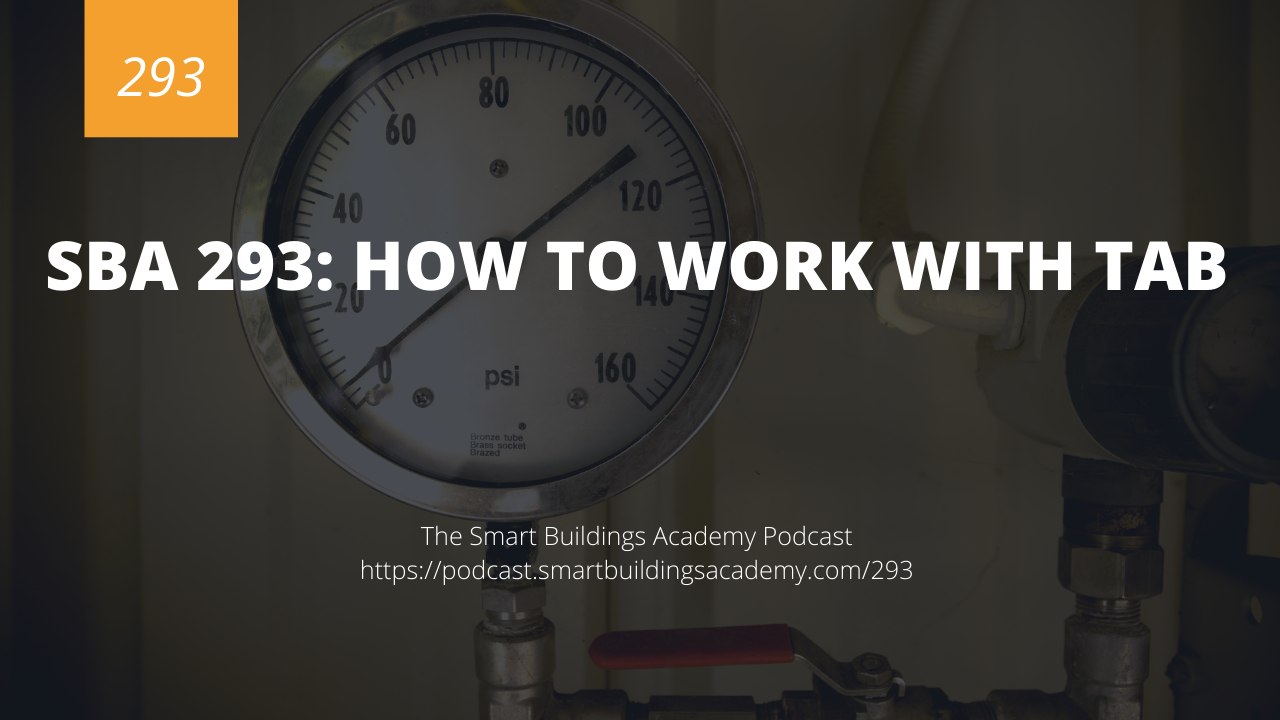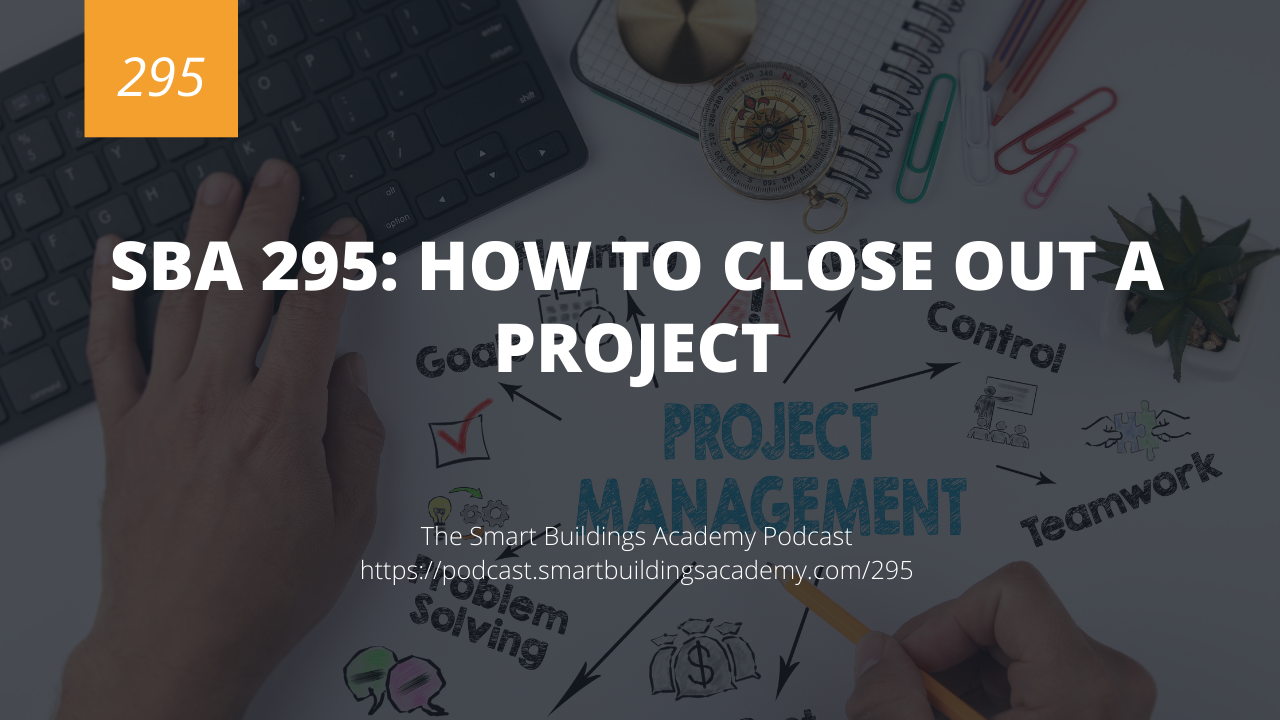In this episode we discuss how to work with and support commissioning agents on your building automation projects.
Click here to download or listen to this episode now.
Resources mentioned in this episode


Transcript
Phil Zito 0:00
This is the smart buildings Academy podcast with Phil Zito episode 294. Hey folks, Phil Zito here and welcome to episode 294 of the smart buildings Academy podcast. In this episode, we are going to be talking about how to work with a commissioning agent. I just want to remind you all that at the time of this episode, which is October 25, that we are still looking to add a third corporate account executive. So if you reside in the United States, you have building automation experience, and you would like to work for us selling training and workforce development services to the contractor owner and OEM market then definitely reach out we'd love to talk to you, you can reach out at support at smart buildings academy.com To learn more information about the role. Alright, let's talk about commissioning agents. So what is the big deal with commissioning? What is it? What are commissioning agents? What does all of this mean to you? Well, traditionally, commissioning has meant increased labor requirements, increased cost, and just increase time on projects. But done right, it actually results in a better end product.
Phil Zito 1:25
And for those of you listening, you may be asking how does it result in a better end product? How does it result in a building that is more functional that is actually achieving the standards that were set by both the engineer as well as the owner. While it does that by this thing called functional testing. Now, that is kind of a misunderstanding. People hear commissioning, and they think that commissioning equates to functional testing. And it doesn't just because you're doing commissioning, does not mean that you are actually going to be doing functional testing as well. So the two are not the same. But you typically will do functional testing when you do commissioning, but you could do functional testing without doing commissioning. And you could do commissioning without functional testing. So how does this all begin? Well, at the beginning of the project, either the owner decides to select a commissioning agent which is known as the owners wrap where the general contractor selects a commissioning agent, which then the commissioning agent works for the general contractor. Now the commissioning agent can do one of three things. And actually, there's way more than three things. But these are the three most common, they can do a paper work only commissioning, which means that they review paperwork, they review documentation, they just review that things are in order, you'll see this a lot in like lead projects that required commissioning. So you'll see paperwork only commissioning, then they could have, you know, partial functional test commissioning, where they write a test plan, but it's only for a sampling of the systems. And basically, they sample the systems. And as long as those system samples work, well then, you know, based on statistics, the rest of the building should work fine. And then you have full blown, you know, commissioning where they will go and write a commissioning test plan. And the test plan will test all aspects of every system. And this obviously is the most expensive and most demanding of the three. But ideally, it should result in the best results. Ultimately, it depends on the competency of your commissioning agent because at the end of the day, I've had to do full functional tests with some commissioning agents who knew way more than me about HVAC systems, and they're really good. And we came out of it with, you know, a really good end product. And I've had to do full commissioning full functional tests with commissioning agents who didn't even know what piece of equipment they were looking at. And so at the end of the day, I would say that the customer would have been better off not even having commissioning, because, you know, at that point, it's just can you convince the commissioning agent that you know what you're talking about, and that what you're doing is right, and make them look good, and then they check the box. I'm just being real with you. That's how it happens sometimes. At the end of the day, though, commissioning begins, as I mentioned, at the beginning of the project is typically going to be listed in both section one and section three of the specification. Once you know that there's commissioning on the project, you want to plan accordingly you want to go and first off, figure out is this going to be just paper commissioning, like in a LEED project is going to be partial functional test or is this going to be full functional test and you want to estimate accordingly, like I said, We're not doing estimating in this construction series, we will be doing a series on sales coming up, I think late in the month of November, if I remember correctly. Now, now that you've estimated and you've done your release to operations, and you hand off the ops, you need to inform the operations team that there is estimating. And this is if you're the salesperson, if you're the operations team, you should be looking or estimating that there's definitely that there's commissioning, obviously, there's estimating, but you want to inform the operations team that there's commissioning, and if you're the operations team, you want to be checking if there's commissioning, if there is commissioning, which the details of which are typically found, section one is going to just give the general Hey, there's commissioning, but Section three is going to go into details of you know, this is going to be full blown commissioning, there's going to be commissioning plan, you need to support data. And you've got to start to reverse engineer. Okay, we've got a full commissioning plan, with full functional test. And it's going to be covering these systems, we need to count for this many hours of support. And we also
Phil Zito 6:12
I, some folks would argue that your sequences and your submittals should be the same no matter whether you have commissioning or not, I'm going to be out, give you the textbook answer the PC, the politically correct answer, and then I'll give you the actual like field answer. So the textbook answer is going to be your documentation, your submittal documents should look no different. Whether you have a commissioning agent or don't have a commissioning agent, but the real world answer is the commissioning agent is often going to change or tweak the sequence of operations. They are, that's just being real. And so your submittals, you should go. And you know, wait, you should make your submittals, obviously, because you need to get the buildings done. But once you've done your submittals, you should go and update your submittals to match with the testing plan, the commissioning testing plan. And you should build your programs in such a way that they can actually be tested. So if you are no, you're going to be tested on a supply fan mode, and a cooling mode and a heating mode. And this is really important. I really hope you all are paying attention here. Because I know some of our podcasts, they can be like a mind dump of information. And all of it is valuable, but some of it is more valuable. It's kind of like that. What is that James, we're all All animals are equal, but some are more equal. Well, all of the information is valuable. But this little tidbit is more valuable, which is hey, let's go and look at how do we make our programs in such a way that when the commissioning agent says okay, I need to see fan failure, you can actually invoke a fan failure state. And it clearly indicates a fan failure state when they say I need to switch from cooling, mechanical cooling to mechanical heating. And I need to see that you can actually have a cooling mode and a heating mode that you can initiate. And you can see that and you Because oftentimes, it's one thing for the system to change and everything. But oftentimes, the commissioning agents, they just want to see the status change. And you can go and have the program doing exactly what it's supposed to do. But if they don't know how to look at the HVAC systems, and they don't know how to really understand that this is changing, then you need to have some sort of visual indicator that says okay, we're in heating mode, we're in cooling mode. Not only does in my opinion, this make a system more serviceable, and it just makes for a better quality installation. At the same time, it also makes it clear to your commissioning agent what's happening and what's not happening. Okay, so you go through functional tests before you ever even get into functional tests, though you should perform a full point to point because what will often happen is you will do a functional test. And during that functional test, an actuator is going to rotate the wrong way. Instead of going clockwise or counterclockwise. Your temp sensor is going to be a little off or a relays not gonna fire something's going to happen. And then that is you do not especially on a partial functional test. It's one thing on a full functional test. You've already got our ideally you have ours budgeted into the project to execute that. But on a partial functional tests, you probably don't have the hours budgeted. And as soon as that one little thing goes wrong. There's oftentimes clauses in their contracts that they can then at your cost required You are at a cost to you at your burden. Basically, they can require you to support a full full functional test for that system type. And you do not want to get stuck in there. That's how six figures, slippage happens, slippage being project costs that exceed the estimated cost. That's negative slippage, right? That's,
Phil Zito 10:21
we are costing more than we should have. Okay, so how do you avoid that you avoid that by performing point to point check out prior to a functional test. Please, please, please, if you hear me on two things, one, use modes and use visual indicators that your system is switching states so that you can satisfy the commissioning agent to perform a point to point check on the system the day before, not the day off the day before the commissioning agent is going to run the functional test. Just go through command everything, make sure it all turns on, make sure it all turns off. And just just get that done. Because the end of the day, you do not want them having to dig any further. Alright. So if you do those two things, you will get through most functional tests just fine. Because at the end of the day, they have to build out the test plan. Which brings us to another point. There's two schools of thought on this school thought one is the commissioning agent builds out the commissioning plan, they build out the test plan, and you just do whatever they ask. And that's perfectly fine. You can do that, that's perfectly fine. It's not my preferred way to do things. But if you're low on manpower, he may be I've never written test plans before which by the way, if you want an episode on how to write test plans for functional test, let us know. And we can definitely do that. That's something I've done a lot in my past life. But if you've never written a test plan in the past, then maybe you don't want to learn on this job, how to write test plans, and so you'll leave it to the commissioning agent. And like I said, that's fine. The second thing you could do is you can assist the commissioning agents on their commissioning plan writing their test plans, which to me personally is a world I like to be in. Because I know how my systems because everyone knows well, not everyone. But most people know that their building automation system has some nuances. You know, Johnson Controls versus ALC versus Trane versus Schneider versus Siemens versus tritium. Each system has things that does well. And things it does not do well, especially when it comes to the programming tools. So if you are able to assist in writing the functional tests, you can write those functional tests in such a way that they really match up with your product line, like for example, Johnson Controls uses a state module and use a state based control. So if I wanted to drive via state based controls, and use like a multiplexer to do that, then great, we can do that. And I can write my test plan accordingly. Look at ALC they're really good at you know, having native guideline 36 programs. So if I have something that's guideline 36, I can natively use my programs. That being said, my programs are going to be written in a specific way. So I may want to influence the test plan the functional test plan to match up with my programs. So what I hope you heard there is know the nuances of your programming tools when you're doing commissioning, and then get with the commissioning agent during their commissioning plan development, and help them write their functional tests in such a way that it aligns with the nuances of your programming tool. Because while in my opinion, every building automation system is the same. It is also different in that the building automation system. They have their little nuances to the programming tools. And you need to be aware of these, especially when you're doing commission. Alright, so there you have it. That's my approach to commissioning gave you a couple really good tidbits that you can apply today. And I encourage you to go and apply those today. Thanks a ton for being here. And I look forward to talking to you in our next episode where we will be talking about how to close out your projects. And in that episode, we're going to take everything we've learned up to this point. And we're going to talk about how can we close out our projects so that we get our retainer, we get into the warranty phase, and we get through the warranty phase without kind of blowing up a project. And I mean, we will have episodes on owner training and warranty. But how to close out your project is more going to be an overview of all of those concepts and everything we've done up to this point. Thanks a ton for being here. Thanks so much. I look forward to talking to you in our next episode. Take care





